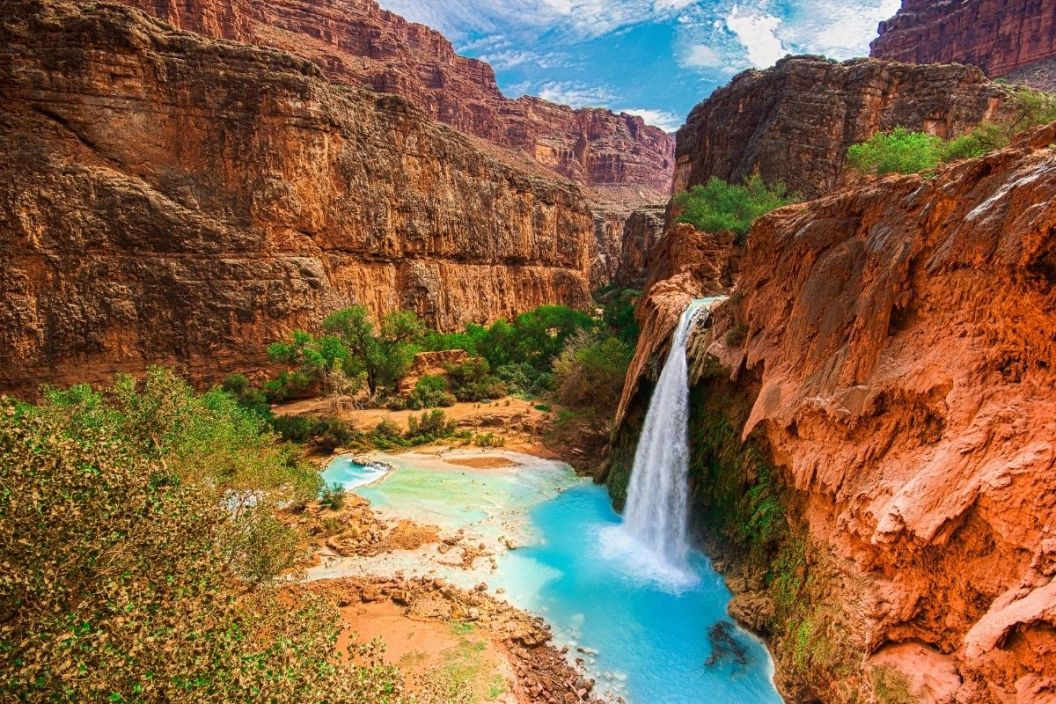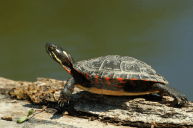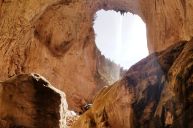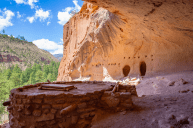Headed out on a road trip through Arizona? Looking to add a bucket list adventure to your next trip in the summer months? Look no further than the amazing Havasupai Falls hike to your 2021 agenda!
There is a chance you have seen pictures of Havasu Falls, a mind-blowingly beautiful set of aquamarine waterfalls and plunge pools that cascade through a red-rock canyon in Arizona. Nestled on the sacred land of the Havasupai Indian Reservation, this bucket list backpacking trip is a hard feat to get access to, and some people try for years!
The Havasupai Indian Reservation
https://www.instagram.com/p/COF0P7tM5sB/?utm_source=ig_web_copy_link
Located on the Havasupai Reservation in Supai, Arizona, this epic outdoor adventure takes some detailed planning, organizing, and preparation. The Havasupai tribe ("people of the blue-green waters") graciously allows visitors to hike and backpack on their land, so paying the utmost respect to the land and its people should always be your top priority.
Havasu Canyon is nestled in the southwest corner of the Grand Canyon National Park. The tribe has been the canyon and land's guardian for over 800 years and consists of a small community of approximately 650 tribal members. The only way in and out of the canyon is by hiking, horseback riding, or getting a helicopter ride from Supai Village. The Havasupai People see more than 20,000 people visit the canyon annually, so it is imperative to follow their rules if you get the opportunity to visit.
Rules & Permits
https://www.instagram.com/p/CNfZZ6cDv_D/?utm_source=ig_web_copy_link
The tribe has important rules in place when visiting, including the requirement of permits, carrying out whatever you bring, no alcohol or drones, you must stay overnight, and you can only drive to the trailhead. If you are planning a trip and have a permit, be sure to read the entire list of guidelines and rules for visiting this incredibly special land.
Obtaining a permit for the Havasu Falls Hike is the hardest part of the entire journey. They do not sell them on-site and you have to make a reservation online. You must go to the Havasupai Reservations website (https://www.havasupaireservations.com/). Some people try for a year or more to get a reservation, so if you get the opportunity, do NOT hesitate. The hottest parts of the year to visit are April through September, but people do this hike year-round!
Permits are available on February 1st of every year at 8 AM for the remainder of the year's open slots. Another pro-tip is to look for reservation cancellations on the New Transfer/Cancellations page. Remember that there can only be one name on the reservation and that it is only valid if the name of the person on the reservation is present at the Check-in Office in the Village of Supai with their valid photo ID.
Where to Stay on Your Trip
https://www.instagram.com/p/B35q_gdnn8O/?utm_source=ig_web_copy_link
Once you snag your permit, there are two choices when it comes to where you will stay: 1) snagging a campground reservation at the grounds near the falls or 2) staying at the Supai Village Lodge. The lodge is located approximately two miles from the campgrounds. The reservations at the Havasupai Lodge are booked by phone only and usually are booked up a year in advance, so you really have to plan for it and make a reservation far in advance. Call (928) 448-2111 or (928) 448-2201 to learn more.
Arriving at the Havasu Falls Hike Trailhead
https://www.instagram.com/p/B1i-hM7h7if/?utm_source=ig_web_copy_link
Hualapai Hilltop is where the trailhead to the Havasu Falls Hike begins. Located off of Highway 66, the trailhead is four and a half hours from Phoenix, three hours from Flagstaff, and four hours from Las Vegas. The last town before the hike is Peach Springs, which is where you need to buy any last-minute provisions such as gas, food, and drinking water.
From Peach Springs, you drive 64 miles on Indian Road 18 with little to no cell phone service (and lots of free-roaming farm animals). Peach Springs or Seligman are both great places to stay the night in a hotel before or after your hike. Depending on the time of year you hike, it's advisable to leave for the trail as early as possible due to the heat. You are allowed to camp in a tent next to your car or in your car in the parking lot next to the trailhead.
Pack Mules
https://www.instagram.com/p/Bx7i8MrAn5_/?utm_source=ig_web_copy_link
RELATED: 25 Cities, Parks, Forests & Attractions to Customize Your California Road Trip
For those who are worried about the almost 10-mile hike into the falls area, there is an option to reserve a donkey as your pack mule. You must reserve this service online before your trip for the cost of $400/mule. Be sure to read the fine print and rules if you choose to opt for using a pack animal. This can be good for first-time hikers or those with pre-existing conditions that may leave them at risk for carrying heavyweight for a longer period of time.
Day Hiking to the Havasupai Campground
https://www.instagram.com/p/CKW-u0xhOaf/?utm_source=ig_web_copy_link
The day you are set to embark on your day hike, it is advised to leave as early as possible. That way, you leave room for the elements like the heat, mistakes, and lots of stops. Someone from the tribe will be there to ask you for your permit so make sure you have it on hand.
The first part of the hike is a decently steep descent through the canyon walls on switchback trails, while the majority of the trail is a more flat river bed surface. The total hike from the trailhead to the campgrounds is 10 miles one way and 20 miles round trip. Plan to take anywhere from 4 to 7 hours on the way down and anywhere from 5 to 9 on the way back up. Definitely stop along Havasu Creek and at any waterfalls you see for a breather and some pictures.
Supai Village
https://www.instagram.com/p/B-x8GUPlp8C/?utm_source=ig_web_copy_link
Once you get into the Village, you are required to check in and get the wristband that you must wear during your stay in the canyon. Campers will delight that there is a place to stop for water if you need it, as well as a last-minute luxury of free Wi-Fi before the short walk to Havasu Falls and the campgrounds.
Once you leave the village area, it's only a short walk to get to Havasu Falls and the campground. You'll walk by some smaller waterfalls on your way. First is the New Navajo falls followed closely by Fifty Foot Falls. There are a lot of beautiful rock formations in the water after these falls which make a lovely curtain down the creek.
Havasupai Campground
https://www.instagram.com/p/B8WisoDnCYb/?utm_source=ig_web_copy_link
Once you make it to the campgrounds, a ranger will help you if you want assistance finding a campsite. Otherwise, you can really camp wherever you want. The one thing to be wary of is the flash flood risk during the summer monsoon season (camp on higher ground).
Waterfalls
https://www.instagram.com/p/CKcKEtxHCmy/?utm_source=ig_web_copy_link
Ah, you have finally made it to camp and can now sit back and enjoy the beauty of the area! On the way to camp from the Village, you will see New Navajo Falls and Fifty Foot Falls. Once you are camped, you can witness the majestic Havasu Falls in action, boasting incredible aquamarine water descending into a huge limestone pool. The water is very cold and the limestone can be very slippery so wear water shoes. Other waterfall highlights include Mooney Falls and Beaver Falls, but the trek to these is not for the faint of heart.
You can find amazing packing lists all over the interwebs for what to bring with you, but remember — you have to carry it all — so the lighter, the better. The key component is a comfortable pair of hiking shoes that you have already broken in. More key items include your backpack, your backpacking tent, a lightweight sleeping bag (and pad), a water bottle, a headlamp, mineral-based sunscreen, food for the entire trip, a hammock, and a dry sack.
Last Minute Havasupai Falls Hike Tips
https://www.instagram.com/p/B3p4oSGlfh4/?utm_source=ig_web_copy_link
Be sure to do your research beforehand. Prepare, prepare, prepare! Read all the online guides you can find and talk to friends who have done this trip or similar backpacking trips, especially if it is your first time. Most of all, have fun, take lots of pictures, and make sure to pay utmost respect to the Havasupai people who allow visitors to re-create in this beautiful place.
Have you had the luxury of exploring the rare beauty of Havasupai Falls? Share pictures of your adventure at our Wide Open Roads Facebook!




